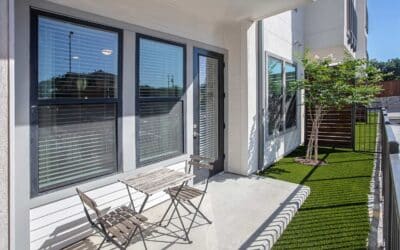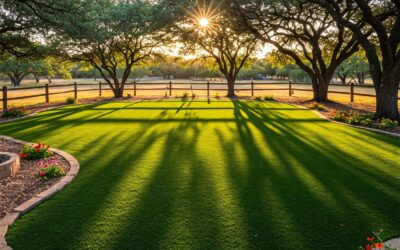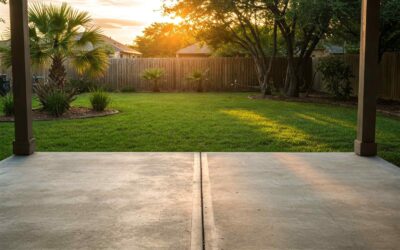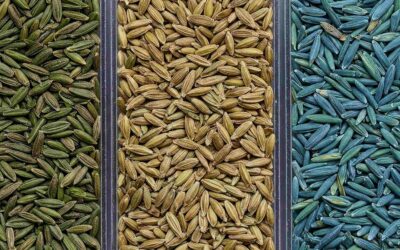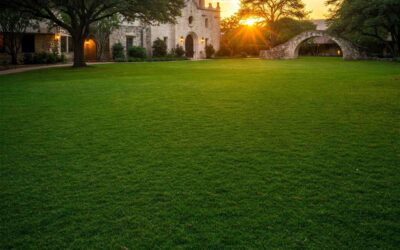Do you need to replace a grass lawn or a patch of artificial grass laid many years ago?
The good news is that the cost of artificial grass can be a bargain when averaged out over its lifespan.
While the upfront costs are more expensive than seeding a traditional grass lawn, an average lifespan of 12-15 years for backyard synthetic grass (and more in some cases) means that after you install your artificial grass, it starts paying you back immediately with its long life and low maintenance costs.
Typical installations average out nationally at $9-12.00 per square foot but this varies by location, grass type and several other factors that are covered below.
So, let’s get into what you need to know when you calculate the potential cost of your synthetic grass.

How Much Does Artificial Grass Cost?
Artificial grass installation costs vary greatly but the national average is somewhere between $9 and $12.00 per square foot (ranging from a few dollars up to $20). The total price of a small installation (500 sq. ft or less), including materials and labor, usually falls somewhere between $3,000 and $7,500.
Generally speaking, the cost of an artificial grass installation increases with the quality of the turf, the difficulty of the installation, and the professionalism of the installation company.
Artificial Grass Cost Per Square Foot
Cost per square foot (sq. ft) is the most common way of costing artificial turf jobs in the U.S.
If you’re in Austin, Texas or surrounding areas, an Artificial Grass Pros expert would be happy to talk through your options with you and help you stay within budget with a free estimate.
Let’s take a quick look at a typical example…
Artificial Grass Price: Example (Austin, TX)
The average yard size in Texas is 14,876 square feet in size — plenty of space for a beautiful large artificial lawn.
So, let’s say you live in Austin, TX, and have an average-sized yard. Say you’re looking for an artificial grass lawn of around 1,000 square feet — about half the size of a tennis court.
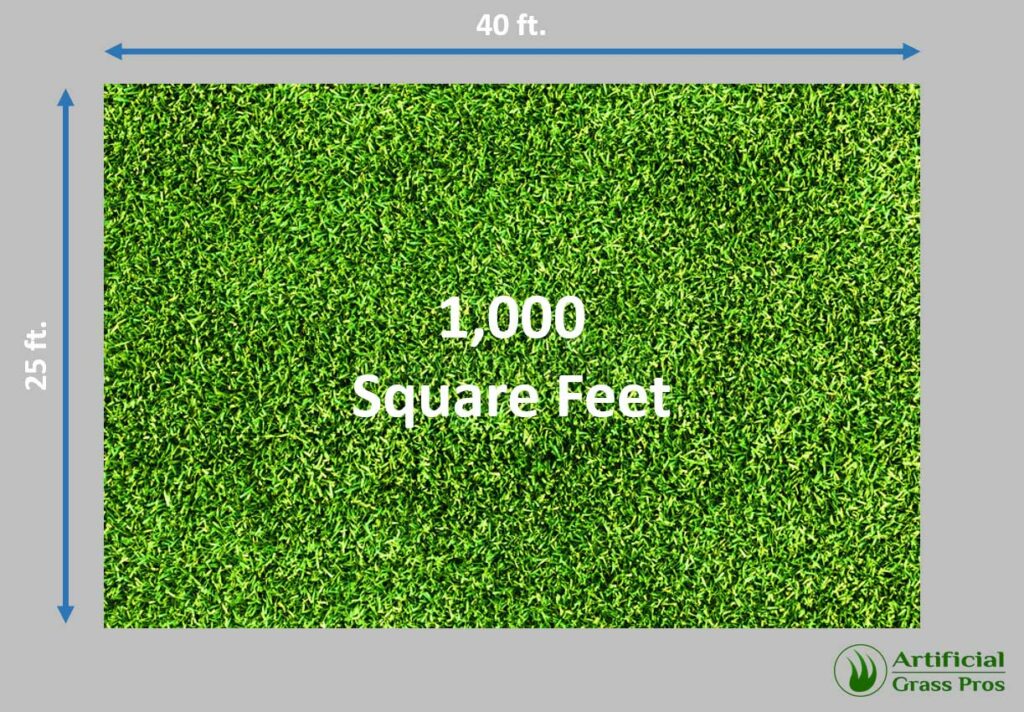
- Using an average per-square-foot cost of $10.00, the total cost comes out to $10,000
- At the lower end of the range ($7 per sq. ft.), the artificial lawn costs $7,000
- At the higher end of the range ($18 per sq. ft.), the artificial lawn costs $18,000
That’s quite a difference. So, while average costs can be a useful guideline, if you’re looking to install an artificial grass lawn, it’s important to consider more precisely what you’re after in terms of quality, appearance, durability, workmanship, and so on.
Sample Average Costs Depending On Lawn Size
Using an average per-square-foot cost of $10.00, here are some other sample costs for various lawn sizes:
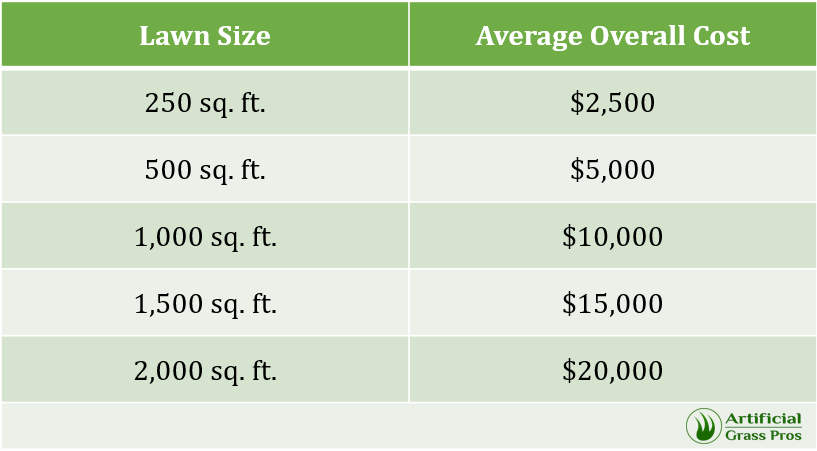
Now let’s take a look at all the factors that could affect the overall cost of your artificial grass installation…
The Main Factors To Consider With Artificial Grass Installation Costs
When you’re considering the comparative costs of artificial turf, being too general will make it difficult to compare like for like.
The truth is that two different patches of artificial grass can differ in many respects:
- Quality of turf
- Materials used for the blades
- Face weight
- Blade shape
- Additional materials used
- Area size
- Area shape and location
- Ease of installation
- The labor required
So, installations don’t always look as stunning as this:
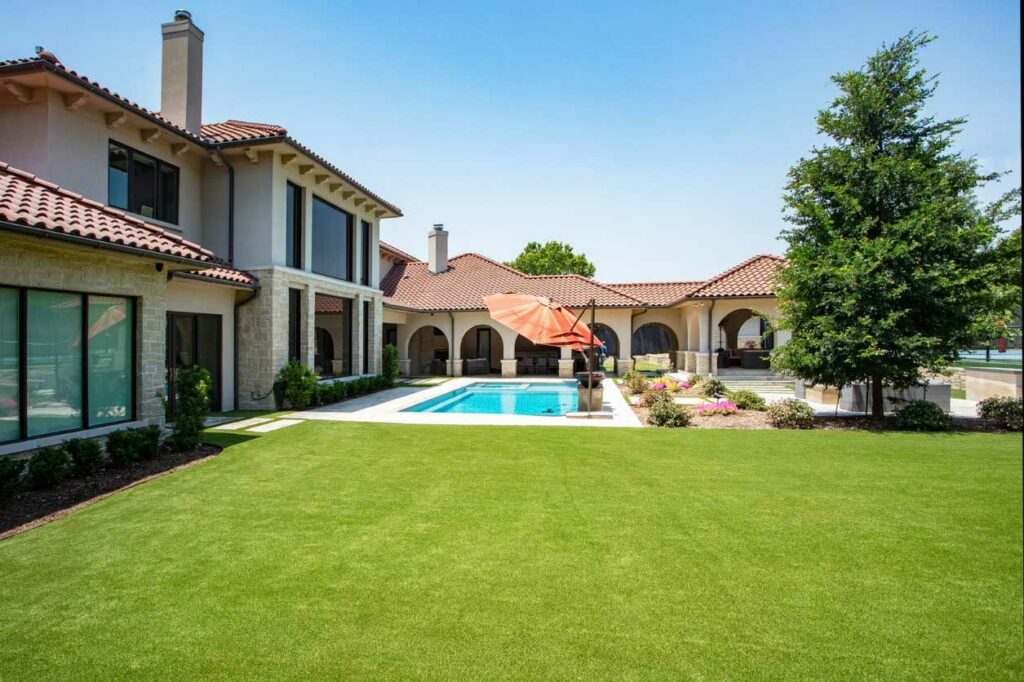
The three standout factors that affect the cost of artificial grass are the turf type, labor costs and size of the area — but there are other factors.
When combined, these factors can make the difference between paying a few thousand dollars for your installation — and two times that amount.
Let’s take a closer look at each one…
The Quality Of The Synthetic Turf
Synthetic turf varies in quality according to the materials used.
Rolls are generally available in 15 foot widths. The length you need will depend on the size of the area you need to cover (see below)
There are three basic choices of material when it comes to artificial grass. The merits and drawbacks of each are discussed below.
Polypropylene
Polypropylene is the least expensive option with artificial turf. It still looks and feels good but is less durable than the other two available options.
The high temperatures we experience in Texas, coupled with high foot traffic can cause the appearance of polypropylene turf to suffer after a few years.
Main pros:
- May be available at a lower cost per square foot than polyethylene and nylon ($2 to $7 per square foot
- Ideal for indoors or shady areas outside
- Soft to the touch
Main cons:
- May suffer with outdoor use with high temperatures, strong sunlight and high foot traffic
Polyethylene
A polyethylene artificial lawn has a more natural “grassy” appearance than polypropylene and a very soft texture.
It is also highly durable even in high temperatures and with heavy foot traffic — and it’s well suited to homes with pets.
Main pros:
- May be available at a lower cost per square foot than nylon ($2.75 to $4 per square foot)
- Looks and feels natural
- Good drainage and non-absorbent
- Good durability (especially the higher-end options)
Main cons:
- Generally, not as durable as nylon
Nylon
Nylon is a highly durable material for artificial turf but this extra toughness usually comes with a higher price tag.
If you experience heavy foot traffic (like on a sports field), have pets, and/or suffer from high temperatures, nylon sod may be the best choice but if you’re looking for a lawn that feels softer, polyethylene may be the better option.
Main pros:
- Unbeatable durability
- Ideal for sports fields and other areas with high foot traffic
- Withstands heat and sunlight well
Main cons:
- More expensive entry point than the other options ($5.50 to $6.50 per square foot)
- Stiffer blades than polyethylene
Summary of the typical cost of an artificial lawn by turf type

*Note these indicative costs are for the artificial turf material only and exclude installation and other costs.
So, for a lawn half the size of a tennis court, your choice of material can make the difference between paying $2,000 or $6,500 for the artificial turf — a huge difference!
The Face Weight Of The Turf
Artificial turf face weight is a measure of the weight of grass fiber per square foot (in ounces). This weight excludes the turf backing on which the grass is stitched (that’s included in the total weight).
Usually, artificial turf in your yard should be a minimum density of 50 ounces. The highest quality turf will be 80 or 90 ounces. Generally speaking, the higher the density, the closer it looks and feels to natural grass — and the higher the price.
On average, the increase in turf price will be around $1 for every 10 ounces in face weight.
Additional Materials
Artificial turf is more than just blades of fake grass. Additional materials make it easier to lay, more durable and more effective. The quality of these materials and how they’re combined in the finished product will also affect the cost per square foot.
The other main materials include:
- Road base: a layer of crushed rock that sits under artificial turf to ensure proper drainage and an even layout. Price varies from $0.30 to $0.70 per sq. ft., adding $300-700 to the overall cost of our 1,000 sq. ft. lawn.
- Artificial grass infill: the grass infill makes artificial turf look and feel like natural grass, replacing the soil weight of real grass, while also adding stability and helping blades stand upright. Antimicrobial grass infill costs more than the standard types but can be helpful if you have pets. Prices vary greatly and for our 1,000 sq. ft. lawn, this will add between $200 and $1,600 to the total cost.
- Seam tape: this joins two intermediary strips of synthetic grass together and is available for between $0.50 and $1.40 per linear foot, depending on the length and width of the rolls you buy.
Insert infographic (see comment)?
Artificial Grass Blade Shape
The shape of the blades may also be a factor that affects the cost of the synthetic grass you select for your yard or commercial area.
Blade shape affects both the appearance and durability of a fake grass area. Some blade shapes feel softer, last longer and are more heat-resistant than others. Manufacturers will charge a premium for these prized qualities.
Briefly, here’s a run-down of the main options with blade shapes:

The most economical blade types are usually the S-shaped and Omega-shaped blades while you may pay a premium for diamond and M-shaped blades.
Note also that most artificial grass includes shorter brown, yellow or grey-colored blades called thatch:
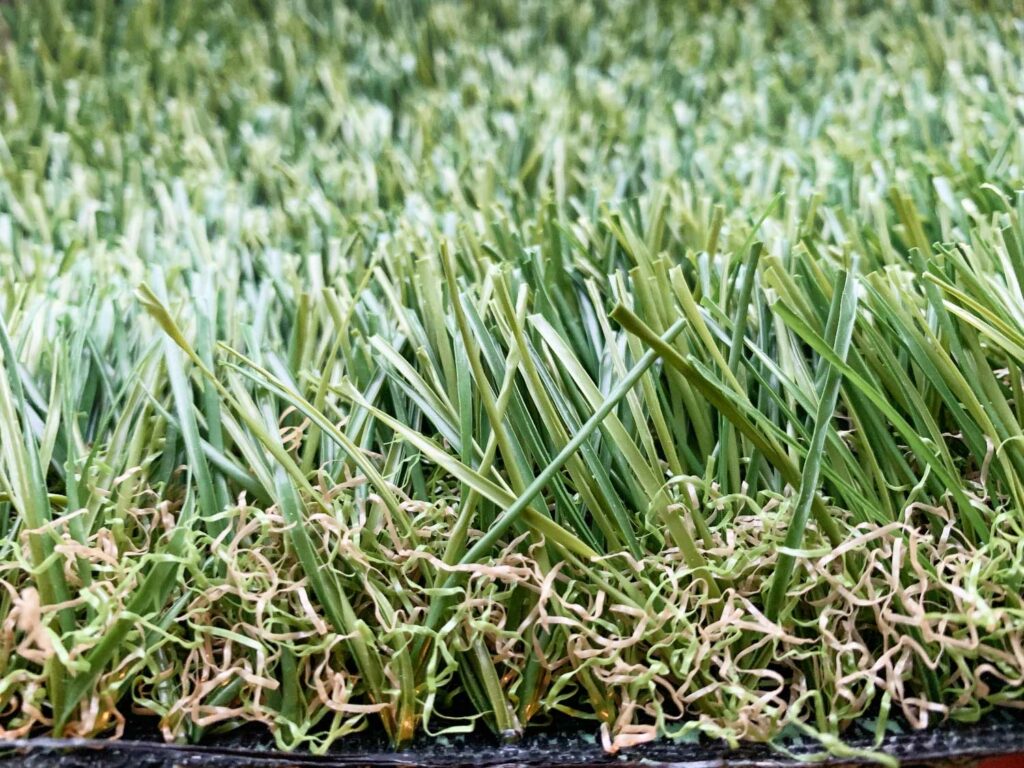
This makes the turf look more natural and helps the main blades stand up straight for a fuller appearance more closely resembling real grass.
The Size Of Area
This one is a no-brainer. The cost of materials and labor will increase if the area of artificial turf increases in size. This one applies regardless of location and with real grass as well as artificial grass.
For instance, commercial areas like the following are often vast:
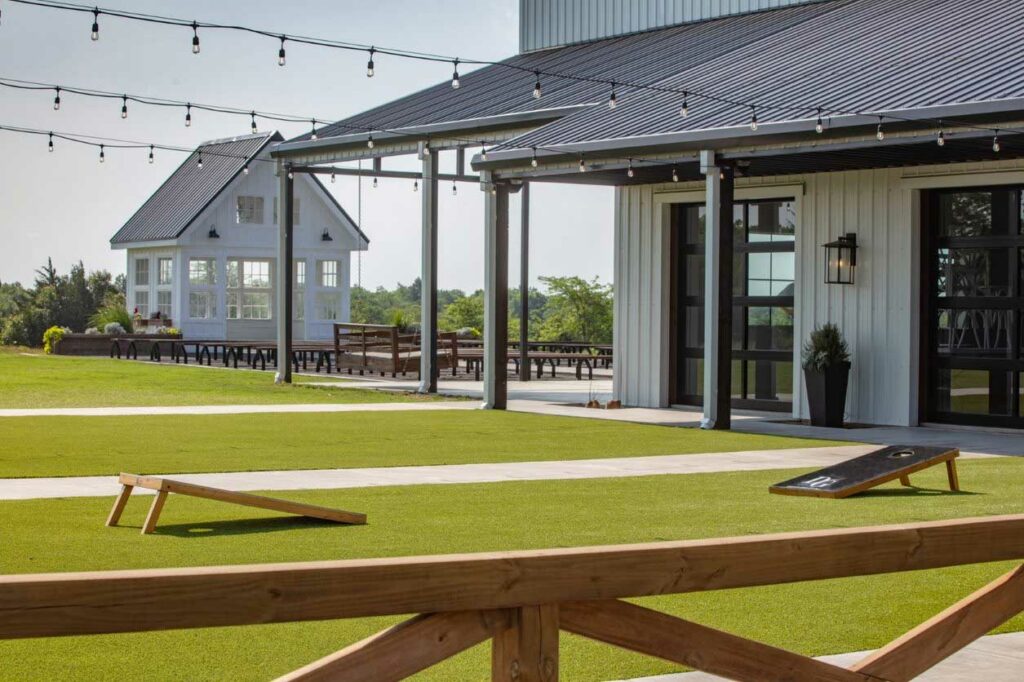
If an area half the size of a tennis court (1,000 square feet) costs $10,000 in total for materials and labor, you can expect that to almost double for an area the size of a full tennis court. It does, however, depend on other factors like the accessibility and shape of the area.
The Shape And Location Of The Area
Not all artificial turf areas are the perfect geometric rectangular shapes of tennis courts. If there are curves, it means that rolls may need extra cutting, potentially leading to additional material and labor costs.
Grass that needs to be installed on a slope can also complicate matters, with hanging timbers required along the perimeter to prevent the grass from sliding and extra work required to level crushed rock and remove the sod.
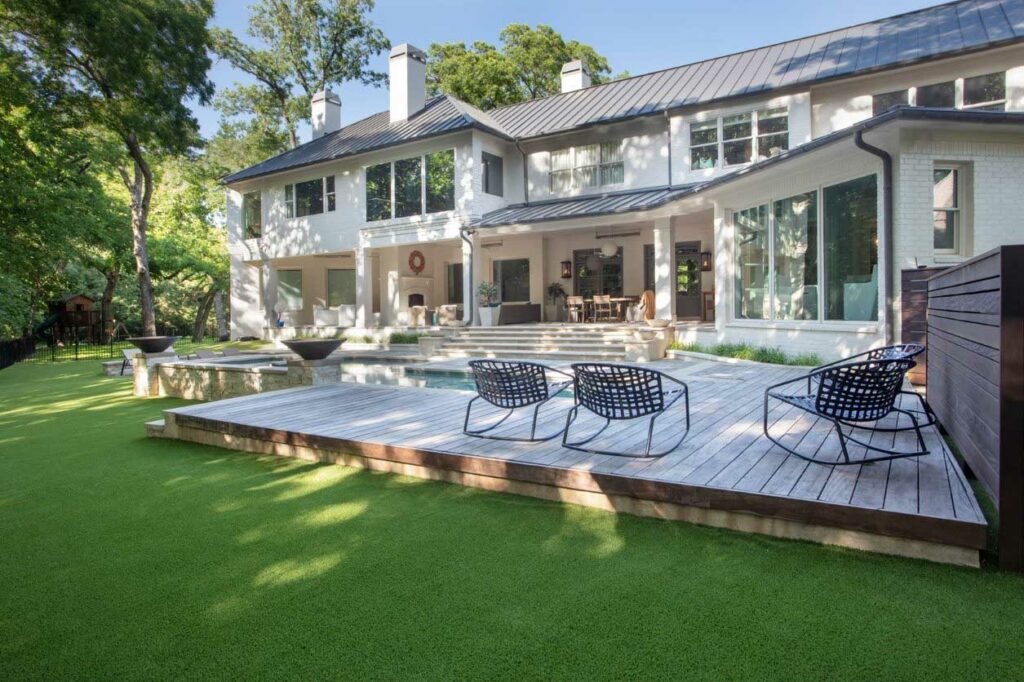
Artificial grass in an area where there are obstacles that need to be worked around, such as trees, stumps and flower beds, also requires extra work to install.
Professional installers are well accustomed to carefully shaping artificial sod to perfectly fit the shape of the area and to work around existing landscape features but it does take more expertise.
Likewise, if you need your artificial grass installed in an awkward location rather than a simple backyard or indoor area, the labor costs may increase. Artificial turf can be installed almost anywhere, including:
- Rooftop areas
- Stairways
- Balconies
- Gazebos
- Children’s play areas
- Swimming pool areas
- Pet play areas
- Walls

The ease of access is an important factor in how long the work will take.
If you have a special request for synthetic grass to be installed in a non-standard location, speak to a professional at Artificial Grass Pros for reliable advice and a free estimate.
Labor Costs
Most artificial turf companies will work out the labor costs for a particular installation on a per-square-foot basis. This is usually anywhere from $3 or $4 per sq. ft. up to $9 or $10 per sq. ft.
For our 1,000 sq. ft. example, that’s anywhere from $3,000 to $10,000. You can expect lower labor costs for a relatively simple backyard installation that takes one or two days.
More complex jobs, even of the same surface area, can take twice that time or longer than a week.
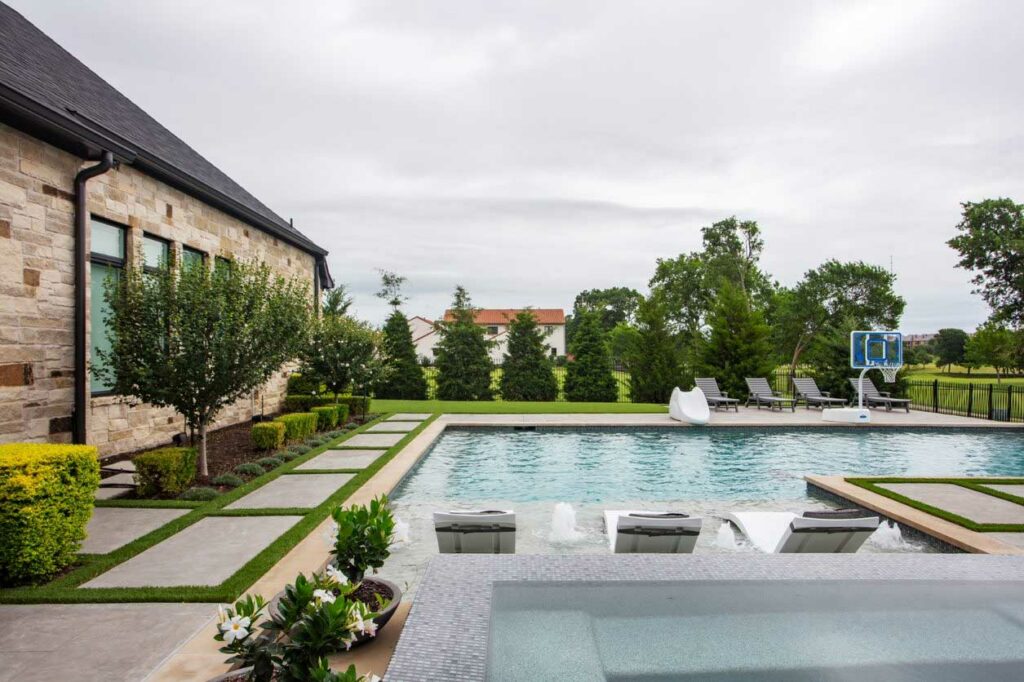
For a rough calculation, you can count on labor costs making up around half of the total cost of the installation.
Do your due diligence and get several installation quotes to make sure that you’re not being taken for a ride. Remember, just as not all artificial grass is the same quality, neither is the quality of the labor. Never be tempted to use an installation company without the right reputation.
Some homeowners are attracted by the prospect of saving these costs entirely and going down the DIY route. Before you decide to do that, read on because it’s not without its perils…
Operational Costs
The operational costs may not be itemized in the proposal of fees you receive from your artificial grass company but they will likely be built into the quotation.
Operational costs refer to charges associated with transporting materials to and from the worksite. These generally relate to two areas:
- Delivery fees: these generally depend on the volume of turf and other materials required (size of the area), the manufacturer(s), the location and other factors. There are also labor costs involved with unloading the materials. Each trip may cost from $150-300.
- Hauling fees: when you install synthetic grass, you’ll need to remove and haul away old turf, soil and grass. These fees will depend on the size of the area (volume of waste to be hauled) and whether a truck and trailer can manage the job or a container is needed. Two truckloads might cost around $700 to $800.
Other Optional Service Costs
There are several other optional service costs that you may need to add to the overall costs, depending on the existing setup in your yard.
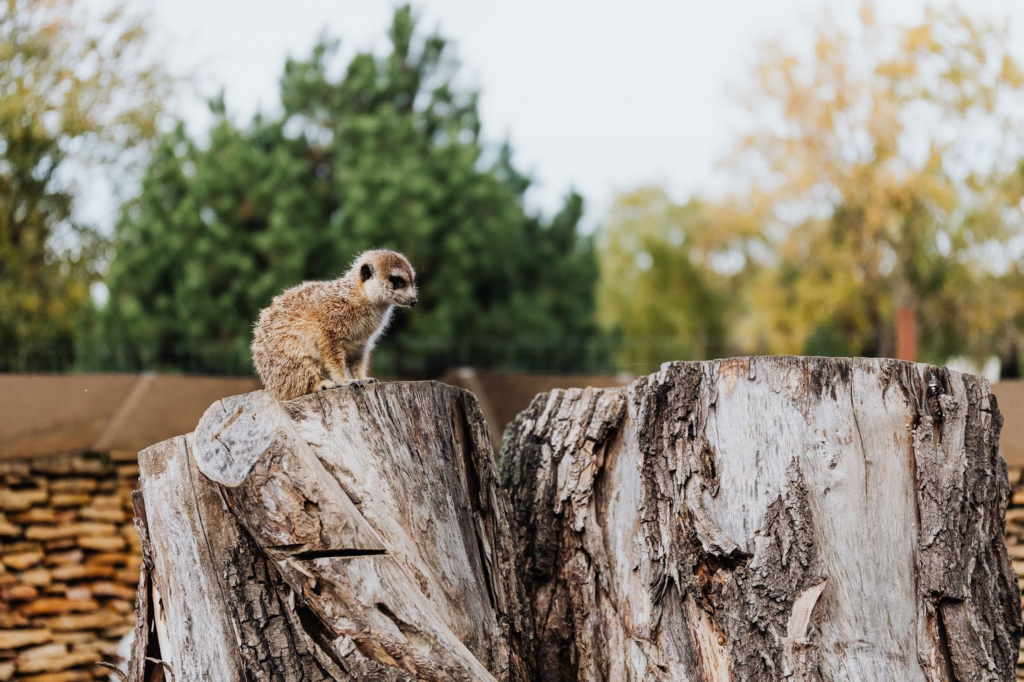
These might include:
- Removal of trees/stumps: this service can cost as little as a few hundred dollars or as much as over a thousand, depending on the type, size and location of the tree.
- Landscape edging: this provides a metal, wooden, stone, brick, concrete or plastic frame to contain the road base and anchor artificial turf margins. Typical costs are between $4 and $11 per linear foot.
- Retaining walls for raised flower beds: a great way to keep your favorite plants and flowers to beautify your artificial lawn area (or act as edging if you move them to the sides of your new lawn). Typical costs are anywhere between $40 and $350 per linear foot.
Can You Save Money By Installing Artificial Grass Yourself (DIY)?
Are you a wizard with the power drill?
After reading that labor costs are a major component of an artificial turf installment, some homeowners try to cut corners and decide to do the job alone.
Saving money is one potential outcome. Another is a disaster of a synthetic lawn — one that ends up looking something like this:
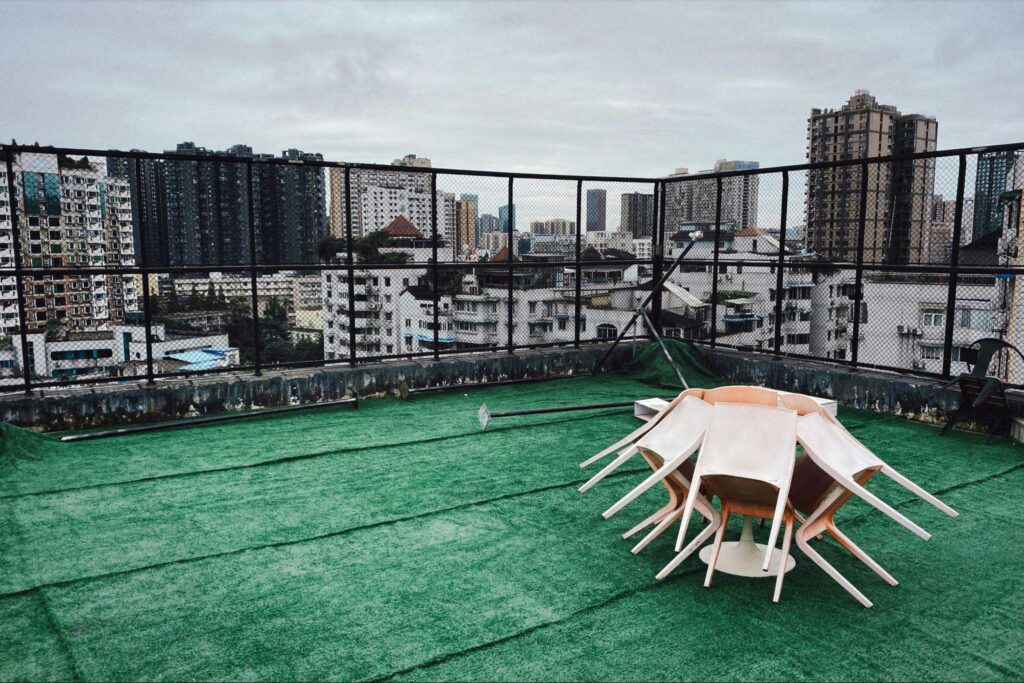
Potential problems from poor installations include bumps in the lawn, visible crushed rock at the margins, weeds and grass growing through, blades reflecting the sunlight, visible seam tape or stakes/staples, etc. Other, less visible problems may also result, such as drainage issues.
Imagine how much it costs to fix up mistakes like this!
A professionally installed artificial grass lawn should last a decade or more even with moderate to heavy traffic — if you choose the right turf and the right installation team.
At Artificial Grass Pros, our professional installers receive extensive training before installations are entrusted to them. You are protected by our 15-year warranty on installation workmanship.
Our team can usually complete an installation in a day or two. It could take a DIY enthusiast a lot longer — with many potential pitfalls along the way.
It’s not simply about rolling out a carpet. Before laying the turf and fixing it in position (itself not easy), you will need to:
- Remove the original surface
- Slope the surface correctly
- Measure precisely
- Compact the ground
- Apply multiple layers of artificial turf materials
This is a job for professionals. Unless you have the necessary skills and equipment, it’s best not to DIY this one.
Here’s a basic list of tools needed (with estimated costs):
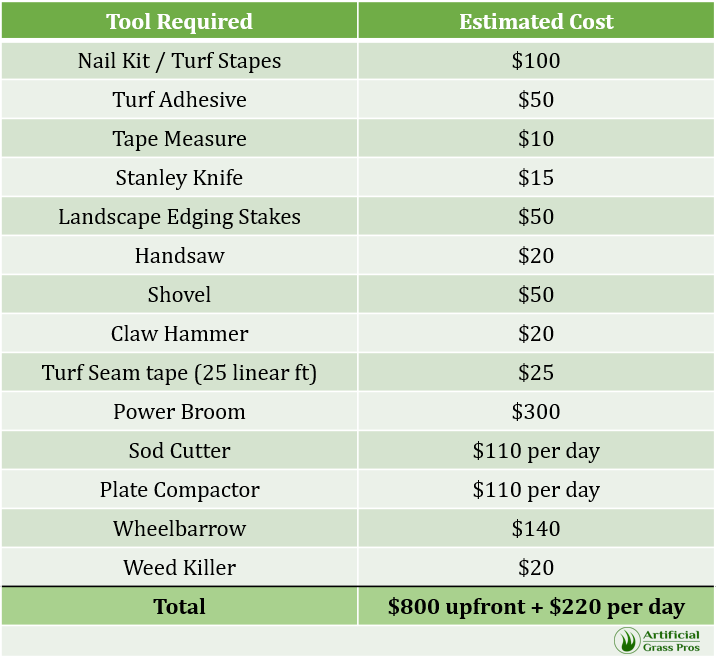
That’s many hundred dollars’ worth of tools you’ll need to complete the job. Before you go down the DIY route, therefore, consider the following:
- How much do you stand to save?
- How much do you stand to lose?
- Do you have the necessary time and energy to put into the installation?
- Do you have the necessary skills to lay an artificial lawn?
- Do you have the right tools and equipment?
- If not, how much will these tools cost?
- How important is an installation warranty for you?
Average Cost Of Artificial Grass VS. Real Grass
There’s no debate: it costs more to install an artificial lawn than lay real grass turf. The main benefits of synthetic grass come later with its durability and low maintenance.
You can usually get a real grass lawn laid for around $1 to $2 per square foot. That makes a 1,000 sq. ft. lawn around $1,000 to $2,000.
We’ve already calculated above that installing the same area using artificial turf would cost $7,000 – $12,000, depending on the many factors that go into the price of synthetic grass lawns (outlined above).
However, real grass sod requires considerable maintenance over the years, which costs money. Depending on your location (remember, large swathes of Texas are much drier than average), if you hire lawn services, the costs associated with maintaining a real grass lawn can exceed $1,000 a year. If that’s the case, your artificial lawn might pay you back within 5-6 years.
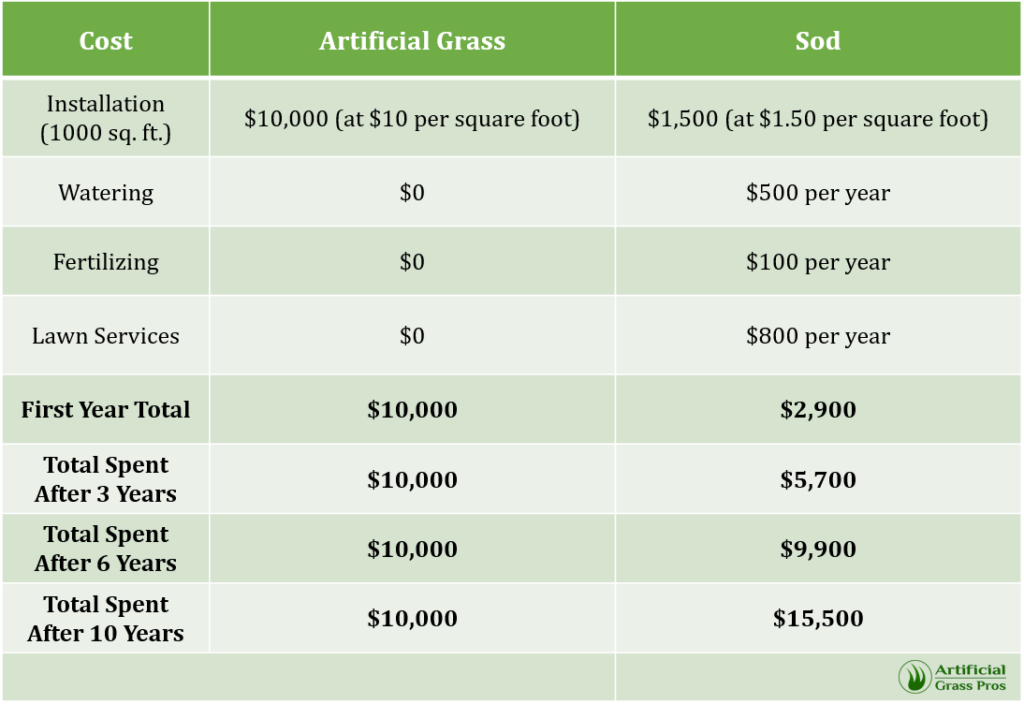
FAQs
How To Save Time AND Money With Artificial Grass…
A synthetic lawn can potentially save thousands of dollars over its lifespan. But the initial installation costs are a major consideration for most homeowners in Texas.
You’ll need to factor in the brand and quality of the synthetic turf you choose, as well as its face weight, blade shape and additional materials that go into its manufacture. You’ll also need to consider the location of the installation and the size and shape of the area required, as well as labor costs, which can be significant.
Despite the labor costs, a DIY installation may be a false economy that ends up costing you more to fix up mistakes.
If you’re based in the Austin area, you can find out more about our professional artificial turf services and get a quote by calling Artificial Grass Pros at 512.296.1500. We provide a limited 15-year warranty that covers all workmanship.

